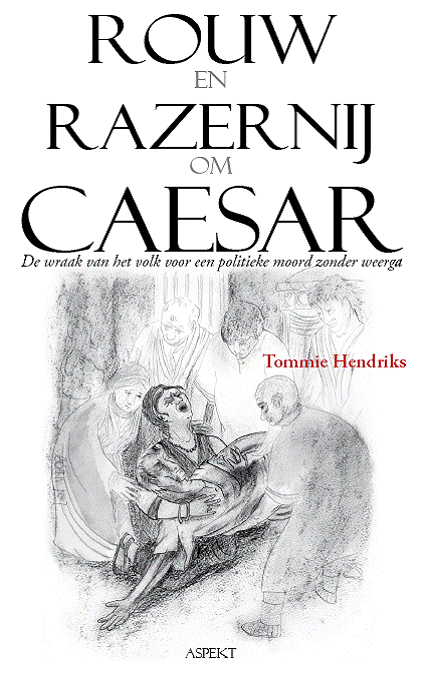
[ redi ad Textus ]

Aantal pagina's: 234
Prijs 16,95
Illustraties: 7 tekeningen van kunstenares Anne Nies Keur / plattegrond van Rome in 44 v.Chr.
ISBN-13: 9789059112957

Voorwoord
Talrijk zijn de wetenschappelijke boeken over het leven, de dood en de betekenis van Gaius Julius Caesar voor de wereldgeschiedenis, talrijk ook de geromantiseerde en gepopulariseerde versies in woord en beeld.
Je kunt je afvragen, wat er nog valt toe te voegen aan het beeld dat wij van Caesar hebben. Na het lezen van het boek van Tommie Hendriks zal het antwoord moeten luiden: erg veel!
De schrijver heeft zich beperkt tot de moord op Caesar op 15 maart 44 v.C., de gebeurtenissen op de drie dagen ervoor en erna, en daarbij minutieus per uur, soms per kwartier de feiten onderzocht. Daardoor ontstaat een verbazingwekkend fascinerend verslag van de gebeurtenissen van die dagen waaruit, meer dan uit welke film of verhandeling ook, het grote gewicht van de persoon Caesar, zijn ongekende populariteit, het enorme verdriet en de woede van het volk
naar voren komen.
De schrijver gebruikt hiervoor een stijl die je zou kunnen omschrijven als een staccato van geweervuur: korte, afgemeten zinnen met feiten en gedachten, waardoor een beklemmend gevoel van onontkoombaarheid ontstaat.
Omdat het feitenonderzoek gebaseerd is op alle bestaande klassieke bronnen en elke zin woord voor woord verantwoord is, mag dit boek worden gezien als het standaardwerk over de moord op Caesar.
Mr. drs. Gerard W.J. Janssen, classicus, vertaler van Plutarchus.
Summary
This study describes the tumultuous events of four days in Rome that can be regarded as a turning point in Roman and hence Western history, the 14th till the 17th of March 44 BCE.
A fair description of this period requires a reliable chronology. The main problem with this is the uncertainty existing up until now about the date of Caesar’s funeral. In the older literature the 20th of March is figured, in the younger one the 18th, a date that is also mentioned by Goldsworthy in his recent Caesar biography. Here it is claimed that Caesar’s funeral took place in the late afternoon and evening of the17th, which can be inferred from the writings of an eyewitness, the orator Cicero, and leads to more consistency regarding the information the antique writers provide us with.
As a result of this new insight it was possible to set up a time table of these days that is almost reliable to the hour. Following this chronology the story of Caesar’s death is extensively reproduced using the information of Appian, Plutarch, Suetonius, Cassius Dio, Nicholas of Damascus, Velleius, Cicero and a few dozen other classical sources.
In order to involve the reader as closely as possible the story of these extraordinarily hectic days has been written in the present tense and direct speech.
* * *
Voor meer informatie zie
http://home.wanadoo.nl/tommiehendriks/caesar/
http://tommiehendriks.wordpress.com/